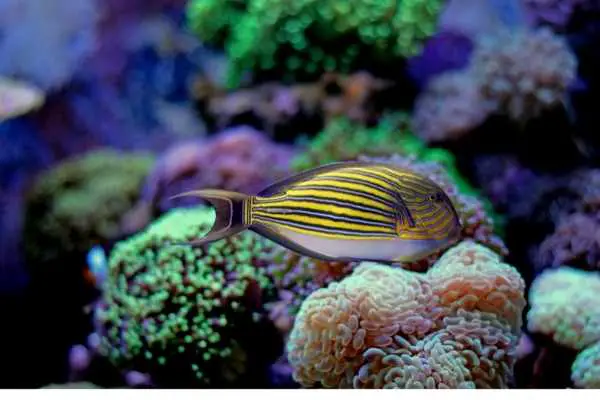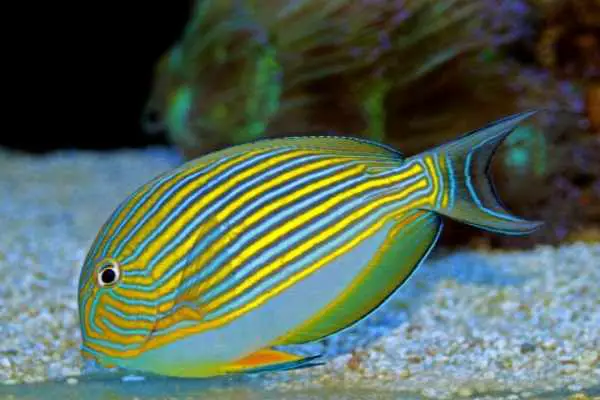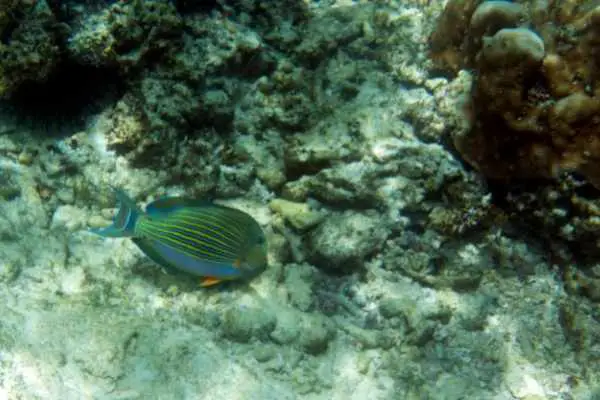Clown tangs (Acanthurus lineatus) combine vibrant pops of color with equally expressive personalities. Put the two together, and you get delightful saltwater fish that top the charts in popularity. Unfortunately, they also rank high in degree of management difficulty. So if you have your high on a new striped addition to your reef tank, make sure you know what you’re getting yourself in for.
Table of Contents: Clown Tang Care
Clown tangs share some of the same needs as other popular members of the surgeonfish family. So you may decide to pop down through the links to the element of care you’re looking for. Or you can read the entire article and find out why they’re so notoriously tricky.
- Quick Facts
- Description of the Clown Tang
- Clown Tang Lifespan
- Creating the Ideal Clown World
- Clown Tang Diet
- Clown Tang Behavior and Tank Mates
- Breeding the Clown Tang
- Pros and Cons
- For More Information
Quick Facts
- Common Names: Clown tang, Clown surgeonfish, Lined surgeonfish, Blue-banded surgeonfish, Pyjama tang, Striped surgeonfish
- Scientific Names: Acanthurus lineatus
- Size: 12-14 inches (30.5-35.6cm)
- Minimum Tank Size: 250 Gallons (946L)
- Reef Safe? Yes
- Care or Experience Level: Expert
- Preferred Diet: Herbivore
- Original Part of the World: Indo-Pacific

Description of the Clown Tang
Clown tangs get their name (any of their common names, actually) from their vibrant colorings. And it’s one of the things that makes them so popular – whether that means a diver spotting them out on a reef or an aquarist setting up a classy marine aquarium. The vivid stripes of blue, yellow, and white help them stand out among the crowd.
Along the bottom, you’ll find a broad streak of white. And this serves as the bottom layer to their scales. Then they add yellow or orange. Next comes a deep or bright blue in horizontal bands. Top it all off with black highlights, and you have a colorful tang that gets attention wherever it swims.
They’re also one of the larger of the surgeonfish. The dorsal and anal fins extend out from the body, producing the expected disc-like shape. And when they stretch out their fins, they’re as tall as they are long.
Juvenile clowns look slightly different from their parents. They have similar coloring, but their tails lack the deep fork. Instead, you’ll see a rounded caudal fin. As they age and grow, the indentation forms.
As members of the surgeonfish family, clown tangs have peduncle spines along the sides of their tails. They use the sharp “scalpels” for defense, as well as offensive battles over territory.
Clown Tang Lifespan
Divers and snorkelers spot clown tangs throughout the Indo-Pacific region. They prefer coral reefs and frequent areas with a strong current. And despite the fact they’re popular menu items for butterflyfish (and humans), they’re long-lived. In the wild, they survive for 25-30 years.
Unfortunately, it’s a different story when they transfer to captivity. The process of capture and transport leads to stress and hunger strikes. And keeping clowns happy and healthy in their new homes often leads to problems. As such, most aquarists don’t see their clown tangs live longer than ten years.

Creating the Ideal Clown World
Clown tangs are robust and active swimmers. They stay near healthy reef environments, everywhere from Fiji to the Maldives and down to Vanuatu. As long as solid currents prevail, you’ll find them as deep as 50 feet (15m). And it’s that swimming ability you’ll need to cater to when you bring one of these striped beauties home.
You can help yourself out with powerheads or wavemakers. These will generate the best water movement and keep your clown feeling comfortable. Combine that with plenty of swimming room – something that requires a careful balance with this particular fish species. They need live rock to perform their daily foraging rounds, but you can’t swamp your tank in the process. Their activity is one of the top reasons people consider adding them to collections. But without room to spread their fins, they’ll end up stressed.
Live rock formations perform double-duty in the aquarium. You’ll provide the nutrients and foraging material a clown needs to remain healthy. But the natural rock structures also offer places to retreat. You may not have larger species in your aquarium that can pose a threat to a clown tang. But these fish have changeable personalities. They need somewhere to seek shelter when they feel vulnerable. And the more nooks and crannies you have available, the better.
Clown Tang Tank Size
While not the largest of the tang species (the sailfin holds that honor), clown tangs still tip the fish scales. They reach 12-14 inches (30.5-35.6cm) when fully grown. Add that to their need for room to forage and swim, and you’ll need a minimum of a 250-gallon (946L) tank. And think LENGTH when you go shopping. Clowns prefer to cruise rather than dive in their daily explorations.
You’ll want a sturdy lid for that aquarium, too. The muscles that power a clown tang through their swimming routines can also launch them free of the water. If they get startled, it’s a behavior known to happen. And the most common time to see this? When you first introduce them to the tank. As you likely spent a hefty amount on your striped import, make sure it doesn’t land on the floor, gasping for air.
Don’t skimp on the filtration, either. Clown tangs aren’t carnivores and prone to messy-eating. However, they DO require pristine water conditions. If you want to protect your investment (and, you know, keep them healthy), consider adding a protein skimmer to your tank. And that’s in addition to a mechanical AND biological filtration system. All three combined should keep your reef tank in tip-top shape.
Are Clown Tangs Reef-Safe?
While some members of the surgeonfish family may take an occasional nibble out of coral polyps in their grazing habits, clown tangs are the exception. This species is entirely reef-safe. They’re careful to leave corals alone during their foraging habits. But when it comes to the pesky green filamentous algae, some aquarists struggle to keep under control? They LOVE it!
Sometimes, aquarists even set up a patch of the algae within the tank for their clowns to graze upon. It keeps the striped herbivores happy and fed while protecting the other invertebrates within the reef tank.

Clown Tang Diet
As herbivores, happy to graze throughout the day on live rock, clown tangs seem easy to feed. And, once they get established within an aquarium, they’re relatively easy to keep happy with the natural flora and fauna within the tank. The problem – and one of the most challenging aspects of their care – is getting these fish to eat in the first place.
Clown tangs get collected off the reef. The stress of the collection process and subsequent transport often leads them to go onto hunger strikes when they arrive in the fish store. And they continue to refuse to eat once they reach your home. Some aquarists have the store hold the fish for a week while the owner attempts to encourage the clown to eat before completing the purchase – as a precaution against starvation.
Clown tangs need the bulk of their diet to come from marine-based seaweeds and algae. Tempting them to remember to eat is often as simple as adding dried seaweed or nori to a veggie clip or beneath a corner of a rock in the aquarium. The clown will encounter the vegetable matter and (hopefully) take a nibble at some point. As the nutrients hit their stomach, it should stimulate their grazing instinct. You should then replenish the clip three times a week – even with proper live rock stocking.
And then you want to add in occasional proteins. (Yes, even for an herbivore) The proteins help keep those colorful stripes looking their best. Once they’re eating properly, you can introduce live or frozen options:
- Brine shrimp
- Krill
- Mussels
- Mysis shrimp
- Nereis
- Tubifex worms
Clown Tang Behavior and Tank Mates
As you might guess when you see the word “tang,” these fish have some issues with aggression. They don’t get along well with each other – or any other fish with the word “tang” in its name. In the wild, clown tangs form harems where the male guards a territory of females. It’s the closest they get to tolerating one another. And it’s NOT a behavior you can successfully duplicate in an aquarium – unless you have a few acres in which to build your tank, anyway.
As juveniles, aquarists feel hopeful for their clowns. The fish start forming the school seen in the wild. They dust off their best manners and get along with one another – no problem. Then the clowns get bigger and older, and that’s when things go south. Because clown tangs don’t develop their bullying problems until they’re adults. And if you haven’t planned appropriately – or arranged for alternate homes for everyone – you could find yourself breaking up fights regularly.
Clowns? They’re bullies. And they’ll pick a fight with ANY fish they come across. Most of the time, it’s due to territory. But you can find them chasing fish around the tank for reasons no one can quite figure out. They go after fish that look like them (i.e., other tangs) first, but any fish with similar stripes or colors is fair game. And that spine’s capable of severe damage. If you want to calm down the aggression, you’ll need to provide as much space as possible. The calmest clown tangs live in MASSIVE tanks.
However, they’re also timid in nature. And you may find them ducking into the live rock structures whenever they find their “bark” isn’t reasonably sufficient. New clown tangs in an aquarium often behave nervously. You should add them LAST to a tank, but you’ll often see those hiding behaviors. They’re complicated little fish.
But they’ll get along with plenty of non-tang options. And when you pair them with different colors, shapes, and patterns, you get a unique display.

Breeding the Clown Tang
Attempting to keep more than one clown tang in an aquarium requires an exercise in patience. And you’ll need plenty if you want to try to sort your males from your females. They look identical. (Well, not IDENTICAL – every stripe pattern is a little different) Females come out a touch larger in the size department, but it’s hard to tell if you don’t have a good selection for comparison.
In the wild, clowns sync up their spawning with the moon’s cycle. You’ll notice groups coming together around the full moon to form spawning aggregations. Males and females pair off and release the fertilized eggs into the currents they love so much. The eggs travel with the plankton before hatching. The fry then swim to the reef.
Unfortunately, this breeding behavior is almost impossible to duplicate in captivity. This is why clown tangs are collected from the wild. And while the collection process leads to high levels of stress and hunger strikes, the species remains incredibly popular.
Pros and Cons
Whether you like their colors, patterns, or energetic personalities, clown tangs top the list for many aquarists. But you need to consider both sides of the equation before you bring one home.

Pros
- Clown tangs are incredibly active saltwater fish that do well in a variety of community aquariums.
- Clowns feed on filamentous green algae, protecting invertebrates from the pest.
- While active grazers, foraging around live rock, clowns are completely reef-safe.
Cons
- Clown tangs don’t breed in captivity, requiring collection from the wild – and HIGH price tags.
- The collection process and transport often cause clowns to go on hunger strikes when they arrive in fish stores.
- Clowns are prone to stress and disease, especially Ich and Head and Lateral Line Erosion (HLLE).
For More Information
Clown tangs consistently top people’s list of favorite saltwater fish. And while they’re troublesome to manage (at times), if you’re determined to bring one home, you’ll want to arm yourself with some more information.
This YouTube video by Vince Putnam demonstrates all of the positive points about clown tangs:
Learn more about other Acanthurus tangs
There are several other closely related tang species that are relatively commonly found. Check out these other care guides to find the perfect tang for your tank:
Here are also a few other tang types beyond the Acanthurus genus that are popular among aquarium owners:
Conclusions
Clown tangs aren’t the largest or even the most expensive tangs out there. But they have big personalities – and some pretty big attitudes. And if you’re up to the challenge of managing their quirks, you couldn’t ask for better saltwater aquarium fish to add to your reef tank.
References
- Fatherree, J.W. 2009. Aquarium Fish: Surgeonfishes, A.K.A. The Tangs.
- Fenner, B. 2014. Surgeonfishes: Tangs for Marine Aquariums.
- Froese, R. and Pauly, D. 2005. “Acanthurus lineatus.” FishBase.
- Michael, S.W. 2001. Marine Fishes: 500+ Essential to Know Aquarium Species.

Leave a Reply